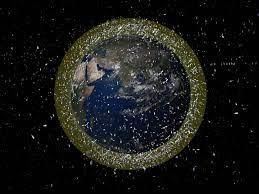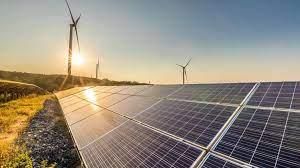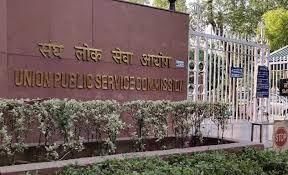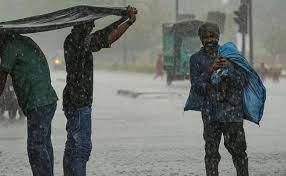Weekly Current Affairs (15th to 21st April 2024) | General Test Preparation for CUET UG - CUET Commerce PDF Download
Space Debris Threat to Earth’s Defenses
The Growing Problem of Space Debris
- Current estimates suggest that there are nearly 10,000 active satellites in orbit, with companies working to deploy tens of thousands more in the coming decades.
- Jonathan McDowell from the Harvard-Smithsonian Center for Astrophysics projects that the number of satellites could reach 100,000 within the next 10 to 15 years.
- The rapid increase in satellite launches is resulting in a significant amount of space debris, including defunct rockets and satellites that are no longer operational.
Potential Impact on Earth’s Magnetic Field and Ionosphere
- The influx of metallic debris from defunct rockets and satellites could disrupt the ionosphere and magnetosphere, which are essential systems that protect Earth’s atmosphere and sustain life on the planet.
- The ionosphere, located roughly 48 to 965 kilometers above the Earth’s surface, is a region where atoms and molecules become ionized by solar radiation, creating a layer of charged particles that reflects radio waves and enables long-distance communication.
- The ionosphere also helps protect life on Earth by absorbing harmful ultraviolet radiation from the Sun.
- The magnetosphere is a plasma cocoon that surrounds the Earth, interacting with the solar wind and cosmic radiation to create a shield against harmful particles and radiation from space.
The Scale of the Problem
- Current estimates suggest that the amount of metallic ash being dumped into the ionosphere annually is equivalent to multiple Eiffel Towers’ worth of debris.
- Unlike meteorites, which are small and contain only trace amounts of aluminum, the wrecked spacecraft are large and consist entirely of aluminum and other highly conductive materials.
- The accumulation of conductive materials in the magnetosphere could potentially trap or deflect parts of the Earth’s magnetic field, leading to regional perturbations and holes above the ozone layer.
Lack of Comprehensive Studies
- Despite the potential risks posed by space pollution, there is a lack of comprehensive studies on its impact on the magnetosphere and ionosphere.
- Plasma physicist Sierra Solter, who has been studying the issue, emphasizes the need for more research to understand the potential consequences of satellite debris on Earth’s plasma environment.
- The rapid expansion of satellite constellations, driven by companies competing for dominance in the satellite internet market, is leading to an alarming accumulation of metallic debris that could disrupt the delicate balance of the magnetosphere and ionosphere, which play crucial roles in protecting life on Earth.
Current Forex Reserves of India
According to the latest report released, India’s foreign exchange reserves fell by $5.4 billion to $643.16 billion. This decline comes after the reserves reached an all-time high of $648.56 billion, following a seven-week gaining streak.
Breakdown of the Decline
- The decrease in the forex reserves was primarily due to a decline in foreign currency assets (FCAs), which fell by $6.51 billion to $564.65 billion. FCAs, the largest component of the forex reserves, include the effect of appreciation or depreciation of non-US currencies like the euro, pound, and yen held in the reserves.
- Gold reserves, on the other hand, expanded by $1.24 billion to $55.8 billion during the same week. Special Drawing Rights (SDRs) decreased by $93 million to $18.08 billion, while the reserve position in the International Monetary Fund (IMF) dipped by $35 million to $4.63 billion.
Recent Trends in India’s Forex Reserves
- In the calendar year 2023, the RBI added about $58 billion to its foreign exchange kitty.
- However, in 2022, India’s forex reserves slumped by $71 billion cumulatively.
- So far in 2024, the reserves have risen by approximately $23 billion on a cumulative basis.
- The country’s foreign exchange reserves last touched their all-time high in October 2021.
- The decline after that can be attributed to factors such as the rise in the cost of imported goods in 2022 and the RBI’s intervention in the market to defend the rupee against a surging US dollar.
RBI’s Role in Managing Forex Reserves
- The RBI closely monitors the foreign exchange markets and intervenes from time to time to maintain orderly market conditions by containing excessive volatility in the exchange rate.
- This intervention is done without reference to any pre-determined target level or band.
- Typically, the RBI intervenes in the market through liquidity management, including the selling of dollars, to prevent a steep depreciation in the rupee.
- The central bank’s actions help in maintaining stability in the foreign exchange market and managing the country’s forex reserves effectively.
About Forex Reserves
India’s foreign exchange reserves are the foreign assets held or controlled by the Reserve Bank of India (RBI). These reserves comprise:
- Foreign currency assets
- Gold reserves
- Special Drawing Rights (SDRs)
- Reserve position with the International Monetary Fund (IMF)
Forex reserves are assets held by a nation’s central bank or monetary authority, usually in reserve currencies like the US dollar, euro, Japanese yen, and pound sterling. These reserves play a crucial role in ensuring the stability of the domestic currency, managing the country’s external trade, and providing a buffer against economic shocks. Adequate forex reserves help in maintaining investor confidence in the country’s economy and provide the central bank with the necessary ammunition to intervene in the market during times of volatility.
IREDA Opens GIFT City Office to Back Green Energy Projects
- The Indian Renewable Energy Development Agency (IREDA) has set up an office in Gujarat International Finance Tec-City (GIFT City), Gandhinagar, to provide foreign currency-denominated debt financing for green hydrogen and renewable energy manufacturing projects.
- IREDA’s GIFT City office will specialize in offering debt options in foreign currencies, enabling natural hedging and substantially reducing financing costs for green hydrogen and renewable energy projects.
- This move is particularly crucial in the context of India’s ambitious National Green Hydrogen Mission, which aims to produce over 5 million metric tons per annum (MTPA) of hydrogen by 2030.
About Indian Renewable Energy Development Agency (IREDA)
- The Indian Renewable Energy Development Agency (IREDA) is a government-owned non-banking financial institution (NBFC) that promotes, develops, and finances renewable energy and energy efficiency projects in India.
- Established in 1987 under the Ministry of New and Renewable Energy
- Provides financial support to various renewable energy projects, including wind, solar, hydro, and biomass
- Offers loans, equity participation, and other financial instruments to project developers
- Plays a crucial role in helping India achieve its renewable energy targets
- Has contributed significantly to the growth of the renewable energy sector in India, with a cumulative loan disbursement of over Rs. 1 lakh crore (approx.)
About GIFT City
- GIFT City, located in Gandhinagar, Gujarat, is India’s first operational smart city and international financial services center.
- It offers a conducive environment for global financial services and has attracted leading banks, insurance companies, and other financial institutions.
- IREDA’s presence in GIFT City will enable it to tap into the ecosystem’s benefits and attract international investors for green hydrogen and renewable energy projects.
- This strategic initiative, announced at the World Future Energy Summit 2024 in Abu Dhabi, is expected to contribute significantly to India’s transition towards a greener future.
India’s Proactive Measures with Energy Sector
- India has taken several proactive steps to support the deployment of energy storage technologies. These include developing a storage requirement roadmap up to 2047, floating technology-agnostic storage tenders, and implementing supportive government interventions for battery manufacturing and pumped storage hydropower projects. The Central Electricity Authority of India estimates a storage requirement of nearly 400 gigawatt-hours (GWh) by 2030-32, with an investment exceeding Rs. 3.5 lakh crores.
IREDA’s Commitment to Renewable Energy Financing
- IREDA has been at the forefront of financing renewable energy projects in India, offering innovative products for emerging technologies at competitive rates. The organization is committed to supporting the deployment of energy storage technologies and facilitating the growth of the green hydrogen and renewable energy manufacturing sectors.
IIT Kanpur & AFMS to Develop Tech for Monitoring Soldiers’ Health in Tough Terrains
The Armed Forces Medical Services (AFMS) and Indian Institute of Technology (IIT) Kanpur have signed a Memorandum of Understanding (MoU) to collaborate on research and development of technologies to address health issues faced by soldiers in difficult terrains. The MoU was signed by Lt Gen Daljit Singh, Director General of AFMS, and Prof S Ganesh, Officiating Director of IIT Kanpur.
Objectives of the Collaboration
- Under this partnership, AFMS and IIT Kanpur will work together to conduct research and develop innovative technologies aimed at tackling the health challenges encountered by soldiers operating in tough environments. IIT Kanpur will provide technical expertise to develop AI diagnostic models at the Armed Forces Centre for Computational Medicine, which has been established at the Armed Forces Medical College in Pune. This centre is the first of its kind among medical colleges in India.
- The MoU also envisions faculty exchange programs, joint academic activities, and the creation of training modules to further the objectives of the collaboration. Lt Gen Daljit Singh stated that AFMS is committed to providing the highest standard of medical care to soldiers and that partnering with premier institutes like IIT Kanpur is an important step in that direction.
Significance of the Collaboration
- The collaboration between AFMS and IIT Kanpur holds great potential to leverage cutting-edge technologies like artificial intelligence and computational medicine to improve healthcare for soldiers. The Armed Forces Medical Services is one of the largest medical organizations in India, providing comprehensive healthcare to serving personnel, veterans, and their families. It operates a network of hospitals, medical centers, and research institutions across the country.
- IIT Kanpur is a leading technology institute known for its expertise in various domains including healthcare. In recent years, it has undertaken several initiatives to drive innovation in healthcare through partnerships with industry and government organizations. In 2023, IIT Kanpur established a dedicated School of Medical Research and Technology to foster interdisciplinary research and technology development in healthcare.
This collaboration may lead to breakthrough solutions that enhance the health and well-being of soldiers.
India’s Proposed Deal with Nvidia
India is considering striking a deal with Nvidia, the US-based manufacturer of graphics processing units (GPUs), to source GPUs and offer them to local startups, researchers, and academic institutions at subsidized rates. This initiative is part of India’s ₹10,000 crore Artificial Intelligence Mission, which aims to boost the country’s AI ecosystem and capabilities.
Proposed Models for GPU Access
Graphics Processing Units (GPUs) are crucial components in the AI ecosystem, enabling faster and more efficient processing of complex mathematical operations required for training and running AI models. In the context of India’s AI initiatives, the government is considering a deal with Nvidia to source GPUs and offer them to startups, researchers, and academic institutions at subsidized rates to boost the country’s AI capabilities and competitiveness.
India is considering two possible ways to provide AI compute infrastructure to its companies:
- Rent-and-sublet model: The Ministry of Electronics and Information Technology will acquire GPUs from Nvidia and provide them to startups, researchers, and others who qualify for the plan on a concession basis.
- Marketplace model: The government will encourage companies to strike their own renting or subletting deals with Nvidia and provide incentives based on incremental productivity achieved through these GPUs, similar to the production-linked incentive (PLI) schemes.
Need for Government Intervention
- GPUs, such as Nvidia’s latest offering Blackwell, are highly expensive, with each unit costing up to $40,000.
- Most computing capacity creation requires hundreds of GPUs at the same location, making it difficult for small companies and startups to invest the required amount.
- India also currently lacks enough GPUs, forcing AI startups and companies to utilize compute infrastructure abroad, significantly increasing their costs.
Status of India’s AI Mission and GPU Deployment
- In March, the Indian Cabinet approved the ₹10,372 crore India AI Mission, under which the government plans to deploy 10,000 GPUs through public-private partnerships. The mission aims to establish a strong AI compute infrastructure to support India’s growing AI ecosystem.
Additional Facts of India’s AI ecosystem and capabilities
- India’s supercomputer ‘AIRAWAT’, installed at the Centre for Development of Advanced Computing (C-DAC) in Pune, is currently the world’s 75th fastest supercomputer and has 640 GPUs. In comparison, the world’s fastest supercomputers have more than 30,000 GPUs.
- The Indian government’s National Strategy for Artificial Intelligence, released in 2018, identified five focus areas for AI development: healthcare, agriculture, education, smart cities, and transportation.
- India ranks third in the world in terms of the number of AI companies, with over 3,000 startups working on AI-related technologies and applications.
- The Indian IT industry is expected to reach $350 billion by 2025, with AI and other emerging technologies playing a significant role in driving this growth.
- India’s potential deal with Nvidia and the initiatives under the AI Mission demonstrate the country’s commitment to developing a robust AI ecosystem.
Coffee’s Prehistoric Origins Revealed Through Genome Sequencing
A report has highlighted the ancient origins of Coffea arabica, the world’s most popular coffee species, through genome sequencing. The findings suggest that Arabica coffee developed over 600,000 years ago in the forests of Ethiopia via natural hybridization between two other coffee species, Coffea canephora and Coffea eugenioides. This makes Arabica coffee significantly older than modern humans.
What is genome sequencing?
- Genome sequencing is the process of determining the complete DNA sequence of an organism’s genome. In the context of coffee’s prehistoric origins, researchers used genome sequencing to analyze the DNA of various coffee species, including Coffea arabica. By comparing the genetic information, they discovered that Arabica coffee originated from a natural hybridization between two other coffee species around 600,000 years ago in the forests of Ethiopia, providing insight into its evolutionary history.
Tracing Arabica’s Lineage and Population History
- By sequencing the genomes of 39 Arabica varieties, including an 18th century specimen used by Carl Linnaeus to name the species, researchers were able to create the highest quality Arabica reference genome to date. Analysis revealed that Arabica’s population fluctuated in response to Earth’s climatic changes over millennia. The population declined during an extended drought 40,000-70,000 years ago before increasing again during the African Humid Period 6,000-15,000 years ago when growing conditions improved.
Cultivation and Spread of Arabica Coffee
- While Arabica coffee evolved naturally, it was later cultivated by humans, likely starting in Ethiopia and Yemen around the 15th century. According to legend, Indian monk Baba Budan smuggled seven coffee seeds out of Yemen around 1600, establishing Indian Arabica cultivars. This paved the way for coffee’s global spread. Today, coffee giants like Starbucks and Tim Hortons exclusively use Arabica beans.
Threats to Arabica Coffee Due to Low Genetic Diversity
- Cultivated Arabica has a low genetic diversity stemming from its history of inbreeding and small population size. This makes it vulnerable to decimation by pests and diseases like coffee leaf rust which causes $1-2 billion in annual losses. The Arabica reference genome identified a region containing pathogen defense genes obtained when a disease-resistant Robusta variety hybridized with Arabica in Timor. This could provide a target for improving Arabica’s pathogen resistance.
Additional Facts of Arabica Coffee
- Over 2.25 billion cups of coffee are consumed worldwide every day
- Brazil is the world’s largest coffee producer, accounting for one-third of global production
- In India, coffee is traditionally grown in the Western Ghats in the south, with the states of Karnataka, Kerala and Tamil Nadu being major producers
- Two main varieties are cultivated in India 1) Arabica and 2)Robusta. Arabica is grown at higher elevations while Robusta is grown in warmer climates closer to sea level
- Indian filter coffee, made by mixing frothed and boiled milk with the infusion obtained by percolation brewing of finely ground coffee powder, is a popular beverage
- The new genomic insights into Arabica coffee’s prehistoric origins and population history provide a foundation for developing varieties that can withstand the impacts of climate change and ensure the beloved beverage’s future.
CBDT Signs Record Number of 125 Advance Pricing Agreements in FY24
The Central Board of Direct Taxes (CBDT) has achieved a significant milestone by entering into a record number of 125 Advance Pricing Agreements (APAs) with Indian taxpayers in the financial year 2023-24. This includes 86 Unilateral APAs (UAPAs) and 39 Bilateral APAs (BAPAs), marking the highest ever APA signings in any financial year since the launch of the APA programme.
What is Advance Pricing Agreements (APAs):
- APAs are agreements between taxpayers and tax authorities that determine the transfer pricing methodology for pricing the taxpayer’s international transactions for future years. The APA programme aims to provide certainty to taxpayers in the domain of transfer pricing by specifying the methods of pricing and determining the arm’s length price of international transactions in advance for a maximum of five future years. Taxpayers also have the option to roll back the APA for four preceding years, providing tax certainty for a total of nine years.
Growth in APA Signings
- The number of APAs signed in FY24 represents a substantial 31% increase compared to the 95 APAs signed in the preceding financial year, FY23. This growth demonstrates the increasing popularity and effectiveness of the APA programme in providing tax certainty to businesses operating in India.
- With the addition of 125 APAs in FY24, the total number of APAs signed since the launch of the APA programme has reached 641. This includes 506 UAPAs and 135 BAPAs. The consistent growth in the number of APAs signed each year highlights the success of the programme in addressing transfer pricing disputes and providing a stable tax environment for multinational enterprises.
International Collaborations with various Partners
- The CBDT has successfully signed BAPAs with several of India’s treaty partners, including Australia, Canada, Denmark, Japan, Singapore, the United Kingdom, and the United States. These agreements are a result of mutual understanding and collaboration between the Indian tax authorities and their foreign counterparts, ensuring a coordinated approach to transfer pricing and the avoidance of double taxation.
Benefits of the APA Programme
- The APA programme offers several benefits to taxpayers, most importantly, providing tax certainty and avoiding double taxation.
- By entering into an APA, taxpayers can have a clear understanding of the pricing methods and the arm’s length price for their international transactions, reducing the risk of transfer pricing disputes. BAPAs provide an additional layer of protection by ensuring that the taxpayer is not subjected to double taxation in the event of a transfer pricing dispute.
- The programme has also contributed significantly to the Indian government’s efforts to promote ease of doing business, especially for multinational enterprises with numerous cross-border transactions within their group entities.
Contribution to Ease of Doing Business
- The APA programme has been instrumental in supporting the Government of India’s efforts to promote ease of doing business in the country. By providing a transparent and predictable tax environment, the programme has helped attract foreign investment and encouraged multinational enterprises to expand their operations in India.
- The success of the APA programme in India has been recognized globally, with many countries seeking to emulate its model. The CBDT’s commitment to the programme and its continuous efforts to streamline the APA process have been widely appreciated by the international business community.
UPSC 2023 results: 1,016 candidates recommended for appointment
- The Union Public Service Commission (UPSC) announced the results of the Civil Services Examination (CSE) for the year 2023 on April 16, 2024.
- A total of 1,016 candidates were recommended for various prestigious government services such as the Indian Administrative Service (IAS), Indian Foreign Service (IFS), Indian Police Service (IPS), and other central services. Aditya Srivastava emerged as the top rank holder, with Animesh Pradhan and Donuru Ananya Reddy securing the second and third positions respectively.
Procedure to Check the UPSC CSE Results
- Candidates who appeared in the examination can check their results by visiting the official UPSC website. Here, they can find the results link on the homepage which leads to a PDF document containing the names and roll numbers of successful candidates. This also includes a downloadable version for record keeping.
Performance and Demographic Analysis
- The results highlighted a total classification of candidates based on the categories such as General, Economically Weaker Sections (EWS), Other Backward Classes (OBC), Scheduled Castes (SC), and Scheduled Tribes (ST). The merit list shows a diverse group from various categories: 347 from General, 116 from EWS, 303 from OBC, 165 from SC, and 86 from ST categories.
Gender Analysis in the Results
- In a shift from the trend seen in the past years where females outperformed males, the 2023 results have shown a dominance by male candidates in the top ranks. This is notable compared to previous years where candidates such as Ishita Kishore in 2022 and Shruti Sharma in 2021 secured the first ranks.
About UPSC Civil Services Examination
- The UPSC Civil Services Examination is one of the national competitive examinations in India, aiming to recruit candidates for various civil services of the government. This examination is conducted in three phases: Preliminary exam, Main exam, and Personality Test (Interview).
Indians Permitted to Hedge Gold Price Risk Overseas Markets
Reserve Bank of India (RBI) has allowed Indian residents to hedge their gold price risk on recognised exchanges in the International Financial Services Centre (IFSC). Governor Shaktikanta Das announced the decision during the Monetary Policy Committee (MPC) meeting where the repo rate was increased by 35 basis points to 6.25 per cent.
What is Gold Hedging?
- In the context of business, particularly in the gold industry, hedging is a strategy used to minimize the risk of potential losses due to fluctuations in the market price of gold. Gold producers, traders, and investors may employ various hedging techniques to protect themselves against adverse price movements and ensure a more stable cash flow.
Examples of hedging strategies in the gold business include:
Forward contracts
- A gold mining company might enter into a forward contract, agreeing to sell a specific amount of gold at a predetermined price on a future date. This locks in the selling price, providing protection against a potential drop in gold prices.
Options
- Gold traders can purchase put options, giving them the right, but not the obligation, to sell gold at a specific price (strike price) by a certain date. This helps limit potential losses if gold prices fall below the strike price.
Futures contracts
- Gold investors can buy or sell gold futures contracts, which are agreements to purchase or sell a specific amount of gold at a predetermined price on a future date. Futures can be used to hedge against price volatility and manage risk.
Current Rule on Gold Hedging
- Prior to this approval, resident entities in India were not permitted to hedge their exposure to gold price risk in overseas markets. This new decision by the RBI opens opportunities for Indian residents to hedge their positions against price fluctuations in global markets.
Benefits of Gold Hedging for Indian Residents
- The approval to hedge gold on recognised exchanges in the IFSC will benefit Indian residents, particularly those involved in the gold import and export industry. By being able to hedge their gold price risk, players in the industry can protect themselves against unfavourable price movements and currency fluctuations. This approval is also expected to increase price competitiveness in the Indian jewellery industry, as it enables businesses to manage their exposure to gold prices more effectively.
India Likely to Experience Above Normal Rainfall This Monsoon: IMD
- The India Meteorological Department has announced that India is likely to experience above-normal rainfall in the 2024 monsoon season, with La Nina conditions expected to set in by August-September.
- This prediction is based on historical data showing above-normal rainfall during previous La Nina events following El Nino periods. El Nino conditions, associated with weaker monsoon winds and drier conditions in India, prevailed in 2023 when the country received below-average rainfall. The southwest monsoon delivers about 70 percent of India’s annual rainfall, crucial for the agriculture sector, which accounts for about 14 percent of the country’s GDP. Positive Indian Ocean Dipole conditions and low snow cover in the Northern Hemisphere are favourable factors for the Indian southwest monsoon, according to the IMD.
- The IMD chief also highlighted that climate change is increasing the variability of the rain-bearing system, leading to more intense heavy rain events and frequent droughts and floods.
Key Factors on Monsoon Forecasting in India
- Three large-scale climatic phenomena are considered for forecasting monsoon season rainfall in India: El Nino, the Indian Ocean Dipole (IOD), and snow cover over the northern Himalayas and the Eurasian landmass.
El Nino
- El Niño is a climate phenomenon characterized by warmer-than-average sea surface temperatures in the central and eastern Pacific Ocean. This warming can have significant impacts on global weather patterns, leading to increased rainfall in some regions and droughts in others. El Niño events tend to occur irregularly every few years and can last for several months to a couple of years. These events can have a major influence on agriculture, fisheries, and economies worldwide, making them crucial to monitor and understand.
Indian Ocean Dipole (IOD)
- The Indian Ocean Dipole (IOD) is a climate phenomenon characterized by abnormal sea surface temperatures in the Indian Ocean. It consists of two poles – a positive pole with warmer waters in the western Indian Ocean and a negative pole with cooler waters in the eastern Indian Ocean.
- The IOD affects the distribution of rainfall in regions surrounding the Indian Ocean, influencing monsoons and weather patterns. It can lead to droughts, floods, and other extreme weather events in affected areas. Understanding and monitoring the IOD is important for predictive weather forecasting.
Snow cover over northern Himalayas
- Snow cover over the northern Himalayas refers to the layer of snow that accumulates on the mountains in the region during the winter months. This snow cover is essential for maintaining the water supply in the rivers that flow from the Himalayas, as it acts as a reservoir that gradually melts and replenishes the rivers during the warmer months. The snow cover also plays a crucial role in regulating the temperature in the region, affecting the climate and ecosystems of the area.
Centre Orders Probe into Surge of Foreigners Receiving Organ Transplants
Ministry’s Concerns and Directives
- The Ministry of Health and Family Welfare has expressed concerns over reports of commercial dealings in organ transplants and has directed the appropriate authorities appointed under the Transplantation of Human Organs & Tissues Act (THOTA), 1994, to investigate transplants involving foreign nationals.
- The Director-General of Health Services has requested the generation of a unique NOTTO-ID for both the donor and recipient in all cases of organ transplants and enforcement of appropriate action in case of any violations.
Actions to be Taken
- Authorities have been instructed to take necessary actions, including suspending the registration for performing organ transplants, against hospitals found violating THOTA regulations. To prevent commercial dealings, an alert was issued to the Ministry of External Affairs regarding foreign nationals traveling to India for organ transplants.
- Following a news report exposing irregularities in organ allocation to foreigners, NOTTO revised guidelines to make it more challenging for foreign nationals to access organs from donors, resulting in a significant increase in transplants for Indian patients.
Impact of New Guidelines
- After the implementation of revised guidelines by NOTTO, the number of Indian patients receiving life-saving organs increased by 56% compared to previous years, as reported by the Transplant Authority of Tamil Nadu. This action aims to address concerns related to commercial dealings and ensure fair and ethical practices in organ transplants involving foreign nationals.
About organ transplants
- Organ transplants involve the surgical removal of an organ from one person (the donor) and its placement into another person (the recipient) who is in need of a functioning organ. This procedure is typically used to treat organ failure or damage caused by disease, injury, or genetic disorders. Organs that can be transplanted include the heart, kidneys, liver, lungs, pancreas, and intestines. Organ transplants can significantly improve a recipient’s quality of life and overall health, but the process involves complex medical considerations and requires careful matching between donor and recipient.
About National Organ & Tissue Transplant Organisation (NOTTO)
- National Organ & Tissue Transplant Organisation (NOTTO) is a government agency in India responsible for coordinating organ donation and transplantation activities. NOTTO maintains a national registry of organ donors and recipients to facilitate matching and distribution of organs. It also conducts awareness campaigns to promote organ donation and trains healthcare professionals in organ transplantation.
- NOTTO plays a crucial role in ensuring fair and transparent allocation of organs, as well as providing support and guidance to organ transplant centers across the country.
Transplantation of Human Organs & Tissues Act (THOTA)
- Transplantation of Human Organs & Tissues Act (THOTA), 1994 was enacted to regulate organ donation and transplantation. The Act aims to prevent commercial dealing in organs, ensure ethical practices, and protect both donors and recipients. THOTA prohibits the sale and purchase of organs, and only allows donations from living-related donors or cadaveric donors. The act also establishes a regulatory authority to oversee organ transplant procedures and ensure compliance with its provisions. Violations of THOTA can result in severe penalties including imprisonment and fines.
|
164 videos|798 docs|1153 tests
|
FAQs on Weekly Current Affairs (15th to 21st April 2024) - General Test Preparation for CUET UG - CUET Commerce
| 1. What is the significance of monitoring soldiers' health in tough terrains? |  |
| 2. How will the collaboration between IIT Kanpur and AFMS benefit the development of technology for monitoring soldiers' health? |  |
| 3. How does the proposed deal with Nvidia contribute to India's technological advancement? |  |
| 4. What are the implications of India experiencing above-normal rainfall this monsoon, according to IMD? |  |
| 5. How does Coffee's prehistoric origins being revealed through genome sequencing impact the understanding of its history? |  |



























